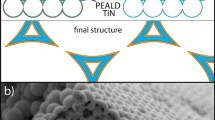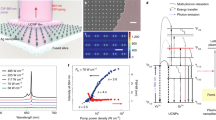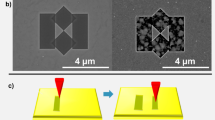Abstract
Plasmonics enables the manipulation of light beyond the optical diffraction limit1,2,3,4 and may therefore confer advantages in applications such as photonic devices5,6,7, optical cloaking8,9, biochemical sensing10,11 and super-resolution imaging12,13. However, the essential field-confinement capability of plasmonic devices is always accompanied by a parasitic Ohmic loss, which severely reduces their performance. Therefore, plasmonic materials (those with collective oscillations of electrons) with a lower loss than noble metals have long been sought14,15,16. Here we present stable sodium-based plasmonic devices with state-of-the-art performance at near-infrared wavelengths. We fabricated high-quality sodium films with electron relaxation times as long as 0.42 picoseconds using a thermo-assisted spin-coating process. A direct-waveguide experiment shows that the propagation length of surface plasmon polaritons supported at the sodium–quartz interface can reach 200 micrometres at near-infrared wavelengths. We further demonstrate a room-temperature sodium-based plasmonic nanolaser with a lasing threshold of 140 kilowatts per square centimetre, lower than values previously reported for plasmonic nanolasers at near-infrared wavelengths. These sodium-based plasmonic devices show stable performance under ambient conditions over a period of several months after packaging with epoxy. These results indicate that the performance of plasmonic devices can be greatly improved beyond that of devices using noble metals, with implications for applications in plasmonics, nanophotonics and metamaterials.
This is a preview of subscription content, access via your institution
Access options
Access Nature and 54 other Nature Portfolio journals
Get Nature+, our best-value online-access subscription
$29.99 / 30 days
cancel any time
Subscribe to this journal
Receive 51 print issues and online access
$199.00 per year
only $3.90 per issue
Buy this article
- Purchase on Springer Link
- Instant access to full article PDF
Prices may be subject to local taxes which are calculated during checkout




Similar content being viewed by others
Data availability
We declare that the data supporting the findings of this study are available within the paper.
References
Maier, S. A. Plasmonics: Fundamentals and Applications (Springer Science and Business Media, 2007).
Ozbay, E. Plasmonics: merging photonics and electronics at nanoscale dimensions. Science 311, 189–193 (2006).
Gramotnev, D. K. & Bozhevolnyi, S. I. Plasmonics beyond the diffraction limit. Nat. Photon. 4, 83–91 (2010).
Schuller, J. A. et al. Plasmonics for extreme light concentration and manipulation. Nat. Mater. 9, 193–204 (2010).
Fang, Y. R. & Sun, M. T. Nanoplasmonic waveguides: towards applications in integrated nanophotonic circuits. Light Sci. Appl. 4, 294 (2015).
Atwater, H. A. & Polman, A. Plasmonics for improved photovoltaic devices. Nat. Mater. 9, 205–213 (2010).
Ma, R. M. & Oulton, R. F. Application of nanolasers. Nat. Nanotechnol. 14, 12–22 (2019).
Valentine, J. et al. Three-dimensional optical metamaterial with a negative refractive index. Nature 455, 376–379 (2008).
Gabrielli, L. H. et al. Silicon nanostructure cloak operating at optical frequencies. Nat. Photon. 3, 461–463 (2009).
Lal, S., Link, S. & Halas, N. J. Nano-optics from sensing to waveguiding. Nat. Photon. 1, 641–648 (2007).
Chung, T., Lee, S. Y., Song, E. Y., Chun, H. & Lee, B. Plasmonic nanostructures for nano-scale bio-sensing. Sensors 11, 10907–10929 (2011).
Fang, N., Lee, H., Sun, C. & Zhang, X. Sub-diffraction-limited optical imaging with a silver superlens. Science 308, 534–537 (2005).
Liu, Z. W., Lee, H., Xiong, Y., Sun, C. & Zhang, X. Far-field optica hyperlens magnifying sub-diffraction-limited object. Science 315, 1686 (2007).
Boltasseva, A. & Atwater, H. A. Low-loss plasmonic metamaterials. Science 331, 290–291 (2011).
Khurgin, J. B. How to deal with the loss in plasmonics and metamaterials. Nat. Nanotechnol. 10, 2–6 (2015).
Naik, G. V., Shalaev, V. M. & Boltasseva, A. Alternative plasmonic materials: beyond gold and silver. Adv. Mater. 25, 3264–3294 (2013).
Palik, E. D. Handbook Of Optical Constants Of Solids Vol. 3 (Academic Press, 1998).
Johnson, P. B. & Christy, R. W. Optical constants of the noble metals. Phys. Rev. B 6, 4370–4379 (1972).
Smith, N. V. Optical constants of sodium and potassium from 0.5 to 4.0 eV by split-beam ellipsometry. Phys. Rev. 183, 634–644 (1969).
Inagaki, T., Emerson, L. C., Arakawa, E. T. & Williams, M. W. Optical properties of solid Na and Li between 0.6 and 3.8 eV. Phys. Rev. B 13, 2305–2313 (1976).
Ge, Y. C. Optical absorption study on the annealing behavior of metallic colloids in KCl:K crystals. Spectrosc. Lett. 31, 123–134 (1998).
Chen, W., Thoreson, M. D., Ishii, S., Kildishev, A. V. & Shalaev, V. M. Ultra-thin ultra-smooth and low-loss silver films on a germanium wetting layer. Opt. Express 18, 5124–5134 (2010).
Yang, H. U. et al. Optical dielectric function of silver. Phys. Rev. B 91, 235137 (2015).
Mori, T. et al. Optical properties of low-loss Ag films and nanostructures on transparent substrates. ACS Appl. Mater. Interf. 10, 8333–8340 (2018).
Ma, R. M. Lasing under ultralow pumping. Nat. Mater. 18, 1152–1153 (2019).
Ning, C. Z. Semiconductor nanolasers and the size-energy-efficiency challenge: a review. Adv. Photon. 1, 014002 (2019).
Wang, D., Wang, W., Knudson, M. P., Schatz, G. C. & Odom, T. W. Structural engineering in plasmon nanolasers. Chem. Rev. 118, 2865–2881 (2018).
Gwo, S. & Shih, C. K. Semiconductor plasmonic nanolasers: current status and perspectives. Rep. Prog. Phys. 79, 086501 (2016).
Hill, M. T. & Gather, M. C. Advanced in small lasers. Nat. Photon. 8, 908–918 (2014).
Berini, P. & De Leon, I. Surface plasmon-polariton amplifiers and lasers. Nat. Photon. 6, 16–24 (2012).
Ma, R. M., Oulton, R. F., Sorger, V. J., Bartal, G. & Zhang, X. Room temperature sub-diffraction-limited plasmon laser by total internal refection. Nat. Mater. 10, 110–113 (2011).
Wang, S., Chen, H. Z. & Ma, R. M. High performance plasmonic nanolasers with external quantum efficiency exceed 10%. Nano Lett. 18, 7942–7948 (2018).
Wang, S. et al. Unusual scaling laws for plasmonic nanolasers beyond the diffraction limit. Nat. Commun. 8, 1889 (2017).
McPeak, K. M. et al. Plasmonic films can easily be better: rules and recipes. ACS Photon. 2, 326–333 (2015).
Babar, S. & Weaver, J. H. Optical constants of Cu, Ag, and Au revisited. Appl. Opt. 54, 477–481 (2015).
Werner, W. S. M., Glantschnig, K. & Ambrosch-Draxl, C. Optical constants and inelastic electron-scattering data for 17 elemental metals. J. Phys. Chem. Ref. Data 38, 1013–1092 (2009).
Ciesielski, A., Skowronski, L., Trzinski, M. & Szoplik, T. Controlling the optical parameters of self-assembled silver films with wetting layers and annealing. Appl. Surf. Sci. 421B, 349–356 (2017).
Hill, M. T. et al. Lasing in metal–insulator–metal sub-wavelength plasmonic waveguides. Opt. Express 17, 11107–11112 (2009).
Khajavikhan, M. et al. Thresholdless nanoscale coaxial lasers. Nature 482, 204–207 (2012).
Zhou, W. et al. Lasing action in strongly coupled plasmonic nanocavity arrays. Nat. Nanotechnol. 8, 506–511 (2013).
Yang, A. et al. Real-time tunable lasing from plasmonic nanocavity arrays. Nat. Commun. 6, 6939 (2015).
Keshmarzi, E. K., Tait, R. N. & Berini, P. Single-mode surface plasmon distributed feedback lasers. Nanoscale 10, 5914–5922 (2018).
Kwon, S.-H. et al. Subwavelength plasmonic lasing from a semiconductor nanodisk with silver nanopan cavity. Nano Lett. 10, 3679–3683 (2010).
Marell, M. J. H. et al. Plasmonic distributed feedback lasers at telecommunications wavelengths. Opt. Express 19, 15109–15118 (2011).
Kwon, S.-H. et al. Surface plasmonic nanodisk/nanopan lasers. IEEE J. Quantum Electron. 47, 1346–1353 (2011).
Lakhani, A. M. et al. Plasmonic crystal defect nanolaser. Opt. Express 19, 18237–18245 (2011).
Ho, J. et al. Low-threshold near-infrared GaAs-AlGaAs core-shell nanowire plasmon laser. ACS Photon. 2, 165–171 (2015).
Ho, J. et al. A nanowire-based plasmonic quantum dot laser. Nano Lett. 16, 2845–2850 (2016).
Lee, C.-J. et al. Low-threshold plasmonic lasers on a single-crystalline epitaxial silver platform at telecom wavelength. ACS Photon. 4, 1431–1439 (2017).
Acknowledgements
We thank H. Su and James N. Hilfiker at Genuine Optronics for help with ellipsometry measurements. We acknowledge the microfabrication centre of the National Laboratory of Solid State Microstructures (NLSSM) for technical support. This work is jointly supported by the National Key Research and Development Program of China (grant numbers 2017YFA0205700, 2018YFA0704401), National Natural Science Foundation of China (grant numbers 51925204, 11874211, 11621091, 61735008, 11774014, 11574012, 61521004 and 91950115), Beijing Natural Science Foundation (grant number Z180011) and the Fundamental Research Funds for the Central Universities (grant numbers 021314380140 and 021314380150).
Author information
Authors and Affiliations
Contributions
J.Z., R.-M.M. and S.Z. conceived and supervised the project. Y.W., J.Y., Y.-F.M. and X.C. fabricated the samples. J.Y. collected dielectric function data. Y.W., J.Y., J.C. and T.L. acquired the surface plasma propagation data. S.W., S.-Y.W. and Y.-F.M. collected and analysed lasing data. H.-Z.C. performed the lasing mode simulations. Y.Z. and L.Z. calculated the plasmon damping rate. Y.W., J.Y., S.W., J.Z., R.-M.M. and W.C. wrote the paper with input from all authors.
Corresponding authors
Ethics declarations
Competing interests
The authors declare no competing interests.
Additional information
Peer review information Nature thanks Michael Cortie, Gururaj Naik and the other, anonymous, reviewer(s) for their contribution to the peer review of this work.
Publisher’s note Springer Nature remains neutral with regard to jurisdictional claims in published maps and institutional affiliations.
Extended data figures and tables
Extended Data Fig. 1 The thermo-assisted spin-coating procedure for the low-loss sodium film.
a, Optical images of the procedure. b, Atomic force microscope topology of the smooth quartz surface, which shows that the root mean square (RMS) roughness is about 100 pm.
Extended Data Fig. 2 Dielectric function measurements for sodium and comparison with silver.
a, Schematic of ellipsometer measurements. The incident light transmits through the upper surface to the lower surface of the silica layer (contact with the sodium interface) and reflects back. The light reflected from the sodium/glass interface can be detected. b, Comparison of real (a) and imaginary (b) parts as well as the figure of merit (−ε1/ε2) (c) of the dielectric functions of silver and sodium (this work). The data for silver are taken from the literature17,18,23,24,34,35,36,37.
Extended Data Fig. 3 Detailed fabrication process of the plasmonic waveguides.
FIB, focused ion beam.
Extended Data Fig. 4 Comparison of silver and sodium plasmonic waveguides.
a, SEM image of the launching and outcoupling structures of plasmonic waveguides. b, The fitted δSPP at different wavelengths on the quartz interface. The dashed line is a fit to the data. c, Propagation measurements at wavelengths of 1,180 nm and 1,450 nm for sodium and silver, with the exponential curves fitted to the data. d, Figures of merit for sodium to silver plasmonic waveguides. The figure of merit of the plasmonic waveguides is defined as the ratio of propagation length to skin depth δSPP/(δd + δm). The sodium data are calculated from the measured dielectric function, and the silver data are calculated using the dielectric function, taken from a number of representative publications17,18,23,24,34,35,36,37.
Extended Data Fig. 5 Detailed fabrication process of the sodium-based plasmonic nanolaser.
BCB, benzocyclobutene; HSQ, hydrogen silsesquioxane; EBL, electron-beam lithography; ALD, atomic layer deposition; CVD, chemical vapour deposition.
Extended Data Fig. 6 Emission spectra (semi-logarithmic scale) of the plasmonic nanolaser shown in the main text for different pump powers.
When the pump intensity is 475 kW cm−2, the device shows single-mode lasing with a side-mode suppression ratio of 20 dB.
Extended Data Fig. 7 Numerical simulation of the cavity modes of the sodium-based plasmonic nanolaser.
a, Measured emission spectra of the plasmonic nanolaser around the lasing threshold, which exhibit two clear cavity modes at wavelengths of 1,257 nm and 1,343 nm respectively. b, Spectrum profile of the two cavity modes, where the resonant wavelength and the linewidth are obtained from the simulation. We assumed Lorentz-shape spectrum profiles here. The simulation shows that the cavity modes at wavelengths of 1,257 nm and 1,343 nm can be identified as plasmonic whispering-galley modes with azimuthal orders of 15 and 14, respectively, and the corresponding quality factors Q of these two modes are 340 and 236, respectively. c, d, Top (c) and side (d) views of simulated electric-field distributions of the plasmonic whispering-galley modes with azimuthal order of 15. e, Electric-field profile E extracted from the white dashed line in d. f, g, Top (f) and side (g) views of simulated electric-field distributions of the plasmonic whispering-galley modes with azimuthal order of 14. h, Electric-field profile extracted from the white dashed line in g.
Extended Data Fig. 8 Comparison of our work to reported plasmonic lasers in terms of the threshold and cavity size.
Blue square symbols represent reported plasmonic nanolasers in the literature. The red star represents our sodium-based plasmonic nanolaser. λ is the lasing emission wavelength in free space.
Extended Data Fig. 9 Stability test for sodium-based reflective plasmonic filters, sodium mirror and plasmonic nanolasers.
a–d, Accelerated ageing tests for sodium-based reflective plasmonic filters. a, Reflectance spectrum of a representative filter device. Inset, schematic of the device. b, Reflectance spectra over time. c, Stability of a fabricated device in terms of the resonance wavelength and intensity at 60 °C, with air humidity 40%. d, Stability of a fabricated device in terms of the resonance wavelength and intensity at room temperature and air humidity 70%. e, f, Stability of the sodium mirror. e, Reflectance spectrum of the sodium mirror against a standard silver mirror (Thorlabs, PF10-03-P01). f, Reflectance of the packaged sodium mirror at wavelength λ = 750 nm over 120 days in air. g, Lasing spectrum of a sodium-based plasmonic nanolaser after six months.
Supplementary information
Supplementary Information
This file contains the Supplementary Methods.
Rights and permissions
About this article
Cite this article
Wang, Y., Yu, J., Mao, YF. et al. Stable, high-performance sodium-based plasmonic devices in the near infrared. Nature 581, 401–405 (2020). https://doi.org/10.1038/s41586-020-2306-9
Received:
Accepted:
Published:
Issue Date:
DOI: https://doi.org/10.1038/s41586-020-2306-9
This article is cited by
-
A sustainable metasurface for smart food labelling
Nature Food (2024)
-
All-in-one, all-optical logic gates using liquid metal plasmon nonlinearity
Nature Communications (2024)
-
Hyperbolic whispering-gallery phonon polaritons in boron nitride nanotubes
Nature Nanotechnology (2023)
-
Reshaping plasmon modes by film interference
Science China Physics, Mechanics & Astronomy (2023)
-
Finite-element Method Analysis of Sodium Based Elliptical Hybrid Plasmonic Waveguides with Ultra-low Loss
Plasmonics (2023)
Comments
By submitting a comment you agree to abide by our Terms and Community Guidelines. If you find something abusive or that does not comply with our terms or guidelines please flag it as inappropriate.



